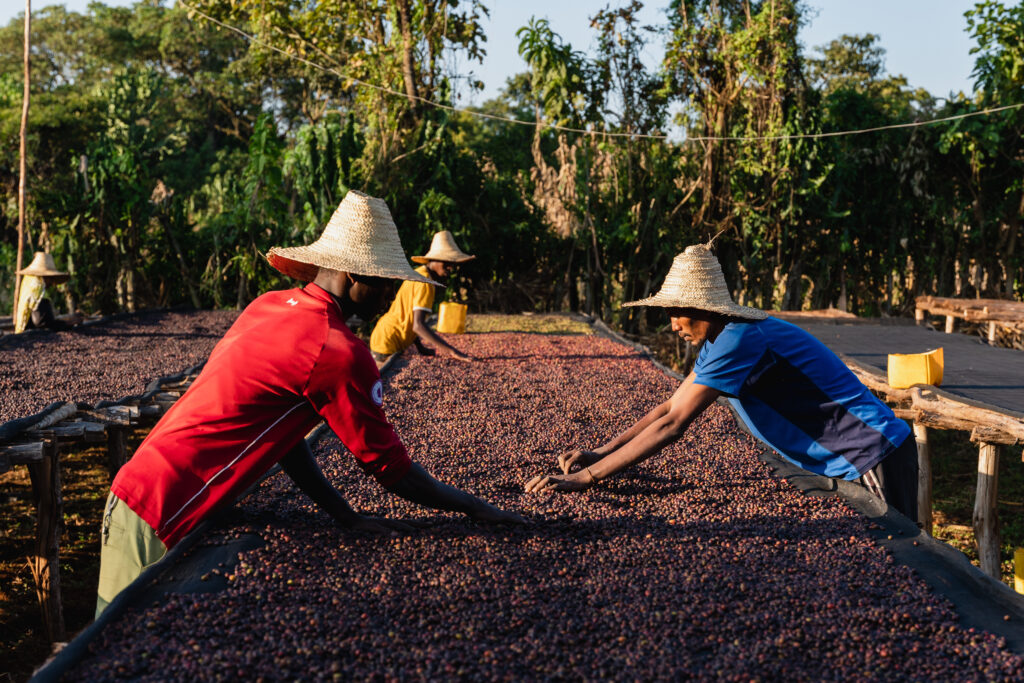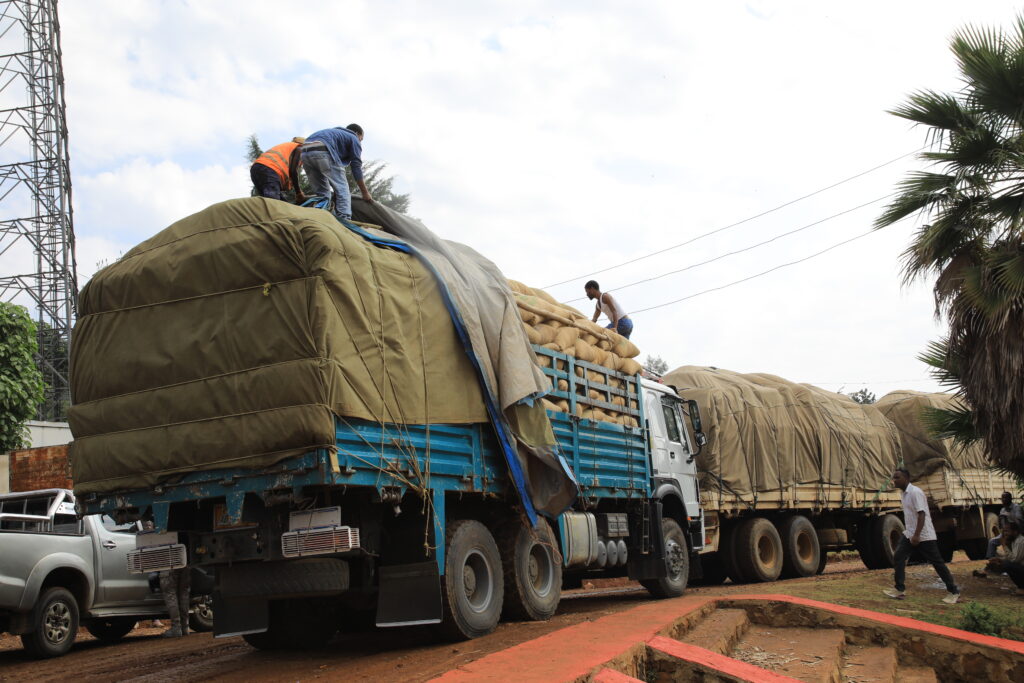A Guide To Navigating The Ethiopian Coffee Market
Introduction
Celebrated as the birthplace of coffee, Ethiopian coffee stands tall on the global arena. With a diverse tapestry of flavor profiles and a rich heritage, it’s no wonder why it is a popular choice for international buyers. Yet, beyond its allure, this origin harbors complexities that often leave buyers struggling to navigate the maze. Behind the scenes, the Ethiopian coffee value chain grapples with myriad challenges—ranging from market fragmentation and frequent regulatory changes to uncorrelated pricing systems and intricate export processes. In this article, we will delve into a succinct history of the Ethiopian coffee market and spotlight how CropConex helps green coffee buyers and Ethiopian exporters navigate this multifaceted terrain together.

Ethiopia’s Early Coffee Market Systems: Auctions to Cooperative Unions
Throughout the 20th century, daily coffee auctions were predominant in Addis Ababa and Dire Dawa. The auctions were the primary system of local trade, representing an early semblance of a free market system. However, this system was not immune to exploitation. Some traders manipulated the auctions to avoid high taxes on coffee, effectively “laundering” their own coffee through the system, resulting in a compromised price discovery mechanism.
Over time, regulatory shifts and high taxation led to widespread smuggling. The 1990s saw reforms aimed at eliminating quotas and simplifying the tax structure, paving the way for private export companies. Ethiopia then began exploring direct trade, which fostered the rise of cooperative unions like Oromia, Sidama, Yirgacheffe, and Kaffa. These unions played a crucial role in consolidating the previously scattered supply chain, ensuring better prices and market stability for their associated smallholder farmers.
Despite these changes, Ethiopian producers continued to face hurdles in market access. Factors like inadequate price discovery, logistical barriers, and limited market entry opportunities for farmers remained persistent challenges.

Restructuring Trade: The Emergence of the Ethiopia Commodity Exchange (ECX)
In 2008, Ethiopia introduced the Ethiopian Commodities Exchange (ECX), an ambitious initiative to restructure and rejuvenate the local commodity auction system. Its primary goal was to establish an efficient mechanism for grading, trading, and disseminating market information.
Coffee was integrated into the ECX’s trading platform by 2009. The ECX sought to bring coherence and structure to a fragmented market system. Key features of the ECX included comprehensive infrastructure for quality grading, issuance of warehouse receipts, streamlined trading processes, timely market information dissemination, contract enforcement, and ensuring timely payments and deliveries. As a result, the ECX fundamentally changed the coffee value chain, acting as an intermediary between smallholder farmers and green coffee purchasers.
Although the system provided a stable market for farmers to get paid for their products faster, local and international specialty coffee buyers raised concerns about the loss of traceability and quality introduced with the new platform. For instance, buyers couldn’t sample the coffee prior to bidding, nor could they access detailed information about the specific micro-regions from where the coffee originated. In the pursuit of efficiency, the ECX often blended regional lots, prioritizing uniformity over specialization.
While some cooperatives were allowed to sell their coffee directly, the majority of Ethiopia’s smallholder farmers were required to sell their coffee to the ECX. As of 2017, about 88% of exported coffee was still purchased through the ECX.

A New Era of Trade: The Coffee and Tea Authority (ECTA) and Market Liberalization
In 2015 the Coffee and Tea Authority (ECTA) was reestablished with an intent to enhance the competitiveness of Ethiopian coffees in the global market. Recognizing evolving market demands, the government in 2017 passed a landmark proclamation that liberalized the coffee sector. This proclamation opened new avenues outside of the ECX and ushered in “direct trade” opportunities for several market players:
- Private Exporters: Who previously were only permitted to buy from the ECX may now own and operate their own processing stations and directly export the coffee they produced. They were also permitted to trade vertically with suppliers such as other processing stations.
- Supplier-Exporters: If a processing station fulfilled the requirements to export, they could be permitted to export their coffee.
- Cooperatives: Rather than needing to export through a Union or sell to ECX, as they had before, cooperatives that fulfilled the government requirements could now obtain export licenses and export directly;
- Private Farmer: Farmers with a minimum of 2 hectares of land could obtain licenses to export directly; and
- Grower-Exporter: Coffee growers could purchase cherry from their neighbors and export coffee from these outgrowers.
Following the 2017 proclamation, the Ethiopian coffee export landscape experienced a seismic shift, with a flurry of new coffee businesses issued export licenses to capitalize on access to the international market. Yet, even amidst this optimism, the industry grappled with challenges—infrastructure limitations, capital constraints, and securing access to international buyers. However, the winds of change were undeniable. Today, a mere 10% of exported coffees transact through the ECX, with the majority sold under the new direct trade models.

The Pricing Paradox: Navigating Inflation, Minimum Prices, and Global Market Dynamics
Coffee is Ethiopia’s most valuable export product, constituting a substantial 25-30% of its GDP. In addition, it serves as the nation’s primary dollar earner, a currency pivotal for importing profitable goods. The recent relaxation in obtaining coffee export licenses posed a challenge: many businesses began undercutting coffee prices, vying for swift dollar access to capitalize on other imported goods. This rapid undervaluation of coffee spurred the Ethiopian Coffee and Tea Authority (ECTA) to introduce the weekly Minimum Registration Price in 2020. These mandatory base prices, segmented by the coffee’s quality grade and region, are based on contracts submitted by exporters to the National Bank of Ethiopia (NBE).
The conflict in Tigray slowed the Ethiopian economy leading to a palpable US dollar scarcity. In reaction, the National Bank intervened with measures to address both this dollar deficit and the climbing inflation by restricting the amount of dollars an export business could maintain in their accounts before mandating a conversion to the local currency. The escalating value of the dollar shone a spotlight on coffee as an attractive gateway to foreign currency, inadvertently buoying its local demand.
Yet, this surge in local demand came with repercussions. The commencement of the 2022/2023 harvest season witnessed soaring prices for coffee cherries, fueled by the escalating costs of essential imports like processing machinery. This resulted in minimum export prices to increase to cover the costs of raw goods, creating an ever-expanding divergence from the global c-market price. Inevitably, this widening chasm between local and global market price instilled a sense of caution in the international market, leading to skepticism surrounding this year’s coffee contracts.

The Path To Export: Multi-Step, Multi-Stakeholder Coordination
Despite a challenging environment for exports this year, Ethiopian coffees play a large part of the global coffee narrative as fifth largest coffee producer in the world. Considering the nuanced regulations for coffee export licenses, export prices, and foreign currency, the path to export requires multi-step, multi-stakeholder coordination.
- Once an exporter and international buyer enter a sales contract, the contract is registered with the National Bank for review, checking the minimum export price.
- The exporter submits the approved sales contract, their export license, and the vertically integrated contract with their regional processing site to the Ethiopian Coffee and Tea Authority (ECTA) for a dispatch letter.
- Once issued, they may begin moving the coffee from the regional warehouse to the capital to be milled and packaged for export.
- After the coffee is milled a pre-shipment sample is pulled and sent to the buyer (upon request) and the Coffee Liquoring Unit, the coffee quality lab under the supervision of ECTA.
- The exporter must also submit the sales contract with their commercial bank for the export permit. The commercial bank is the responsible party to verify with the National Bank of the transaction and dollar to birr currency conversion.
- The exporter gets the shipping instruction information confirmed by the buyer and submits the documents to the Ethiopian Customs Department for clearance.
- After clearing export customs review, the coffee is transported to the port and loaded on the vessel, upon which the final payment is released to the exporter on FOB terms.

Introducing CropConex: A Digital Bridge To Navigate Complexity
CropConex is a supply chain enablement platform designed as the digital layer to coffee sales and logistics. At the moment, CropConex is the only eCommerce business registered in Ethiopia to facilitate market access and direct sales between specialty coffee suppliers and buyers using its end-to-end technology platform.
Our operations interface closely with all the regulatory bodies associated with the coffee supply chain, as well as various other service providers that cater to both sellers and buyers. Effective communication among these entities is paramount for streamlined trading. CropConex stands at the forefront of this endeavor, acting as the central hub for information exchange through the platform.
We empower exporters by offering our platform as a space to showcase their offerings and provide invaluable technical support to coffee-exporting farmers, enabling them to list their individual coffee lots. Prospective buyers can then directly engage with these sellers, fostering clear communication about the sales process through various integrated modules designed for seamless trader interaction. Beyond this bilateral dialogue, CropConex also acts as a conduit for other critical communications, liaising with transport, logistics, and financial service providers. By ushering in such digitized solutions, CropConex is poised to bridge the technological chasm present in the coffee trade, both locally and on the international stage.
CropConex upgrades the coffee trading experience, bridging the gaps in the supply chain and enhancing efficiency through digital innovation. Initially focusing on the intricacies of the Ethiopian coffee supply chain, our platform offers these distinct advantages:
Enhanced Market Access & Direct Communication:
CropConex provides a straightforward communication bridge for coffee buyers and sellers. Moving beyond the typical inefficient exchange methods like WhatsApp and email, our platform lets exporters distinctly list details like coffee type, processing method, available stock, final price, and quantity for buyers to view.
Trustworthy Quality Analysis & Transparency:
Sellers send representative samples to CropConex which undergo meticulous analysis by us and CQI-certified service providers, ensuring unbiased results. In addition, buyers can order samples and perform their own sample analysis and evaluation. Any sample requests from buyers are managed efficiently by CropConex.
Standardized & Compliant Coffee Sales Contracts:
Once a buyer’s estimate is agreed upon, a digital contract is generated on the platform. This contract outlines all post-contractual steps and required documents, ensuring clear, efficient, and transparent communication between both parties.
Ground-Level Logistics & Quality Support:
CropConex ensures impeccable trade integrity, standing as a beacon of support for sellers. Upon contract finalization, our dedicated ground team assists with shipment coordination and validating pre-shipment samples.
Seamless Interactions with Regulatory Entities & Service Providers:
Collaborating closely with key stakeholders like the Ethiopian Coffee and Tea Authority, National Bank of Ethiopia, Ethiopian Customs Commission, and various other ministries, CropConex offers a well-integrated coffee trading solution, ultimately benefiting both coffee farmers and commercial exporters.
CropConex streamlines the sales and export logistics of coffees from Ethiopia, supporting direct trade relationships while mitigating international trade risk. This end-to-end digital solution amplifies the strengths of the Ethiopian coffee trading landscape, making every step more navigable and efficient. Interested in learning more about the CropConex platform and how we work at origin? Contact us to schedule a call or a demo.